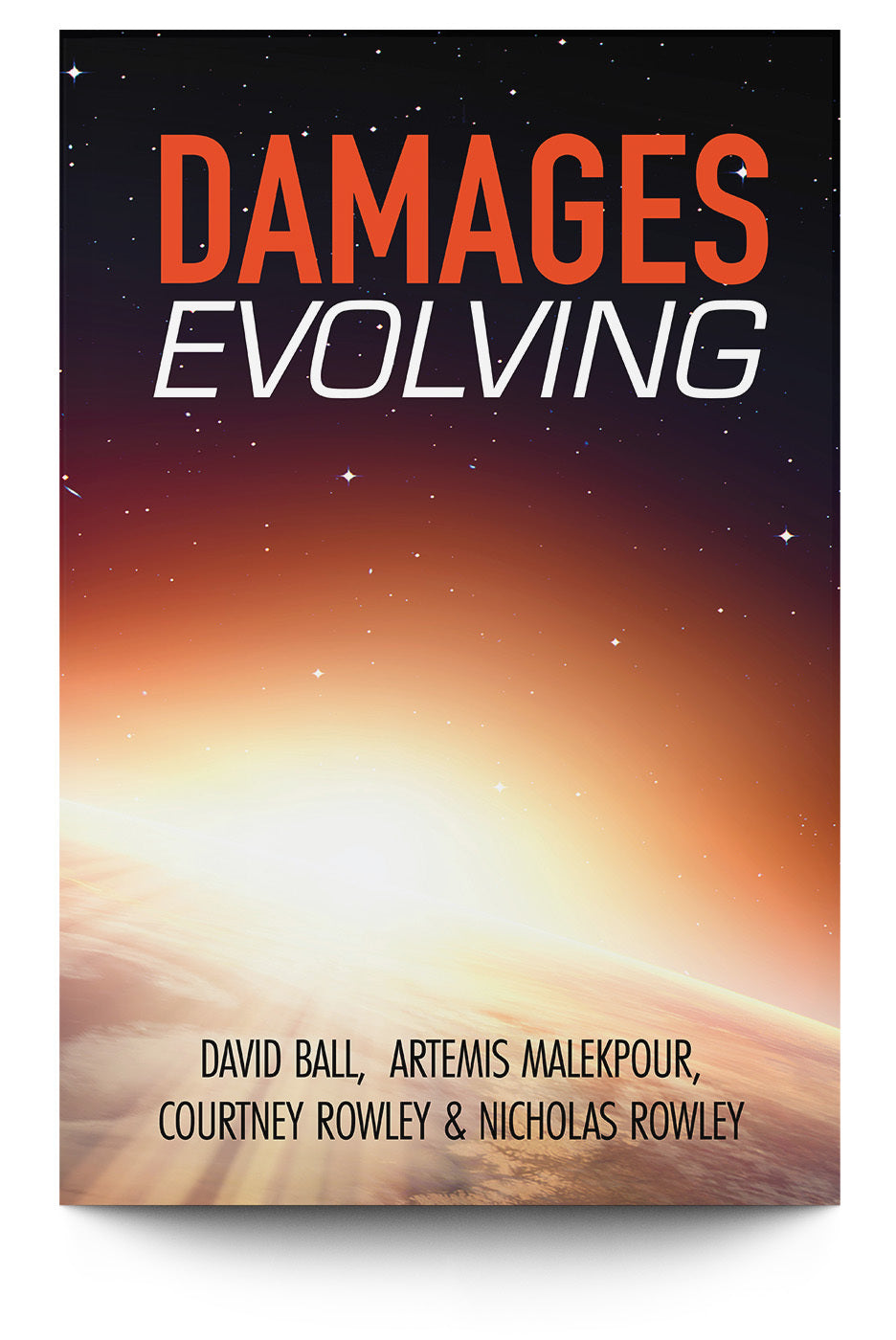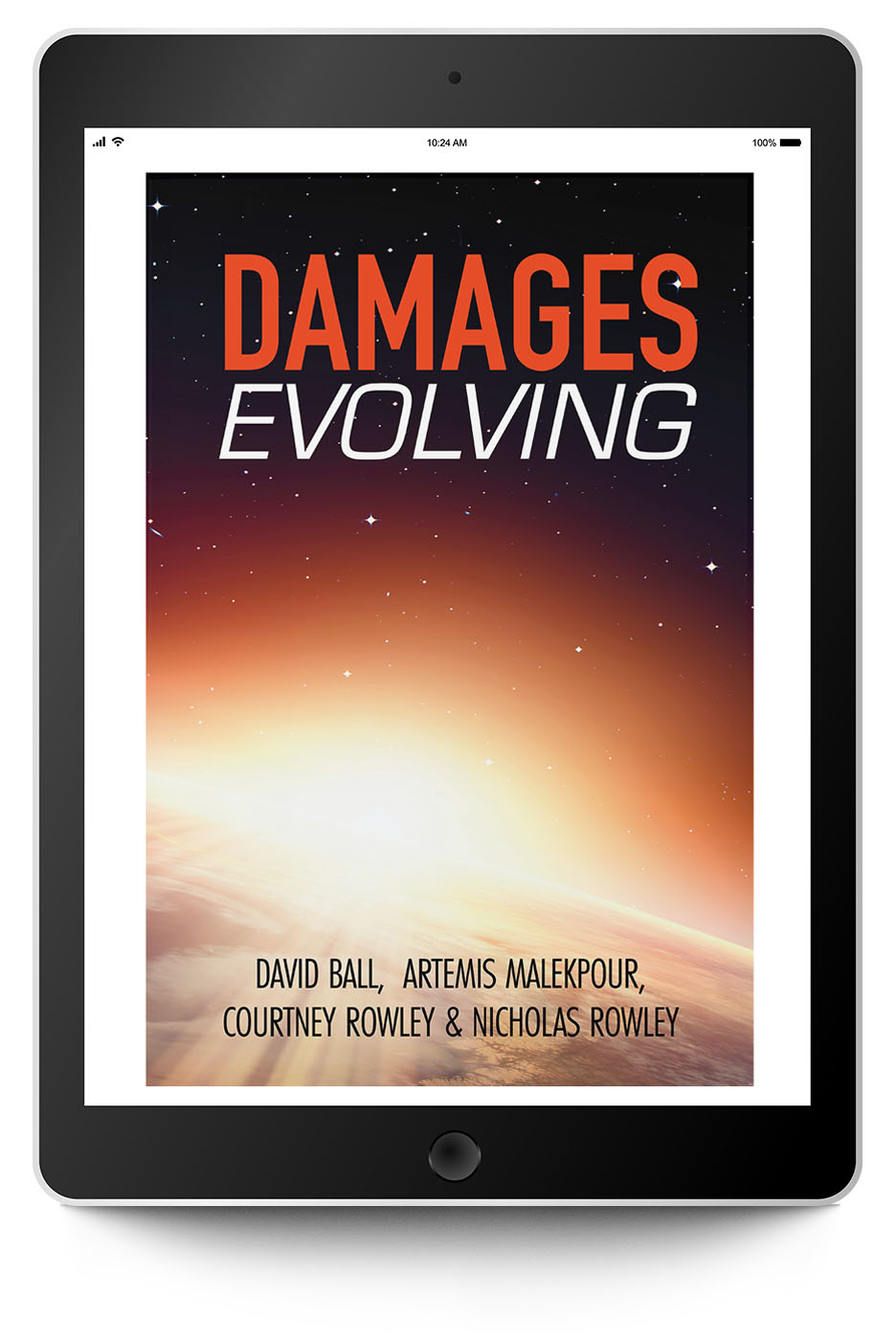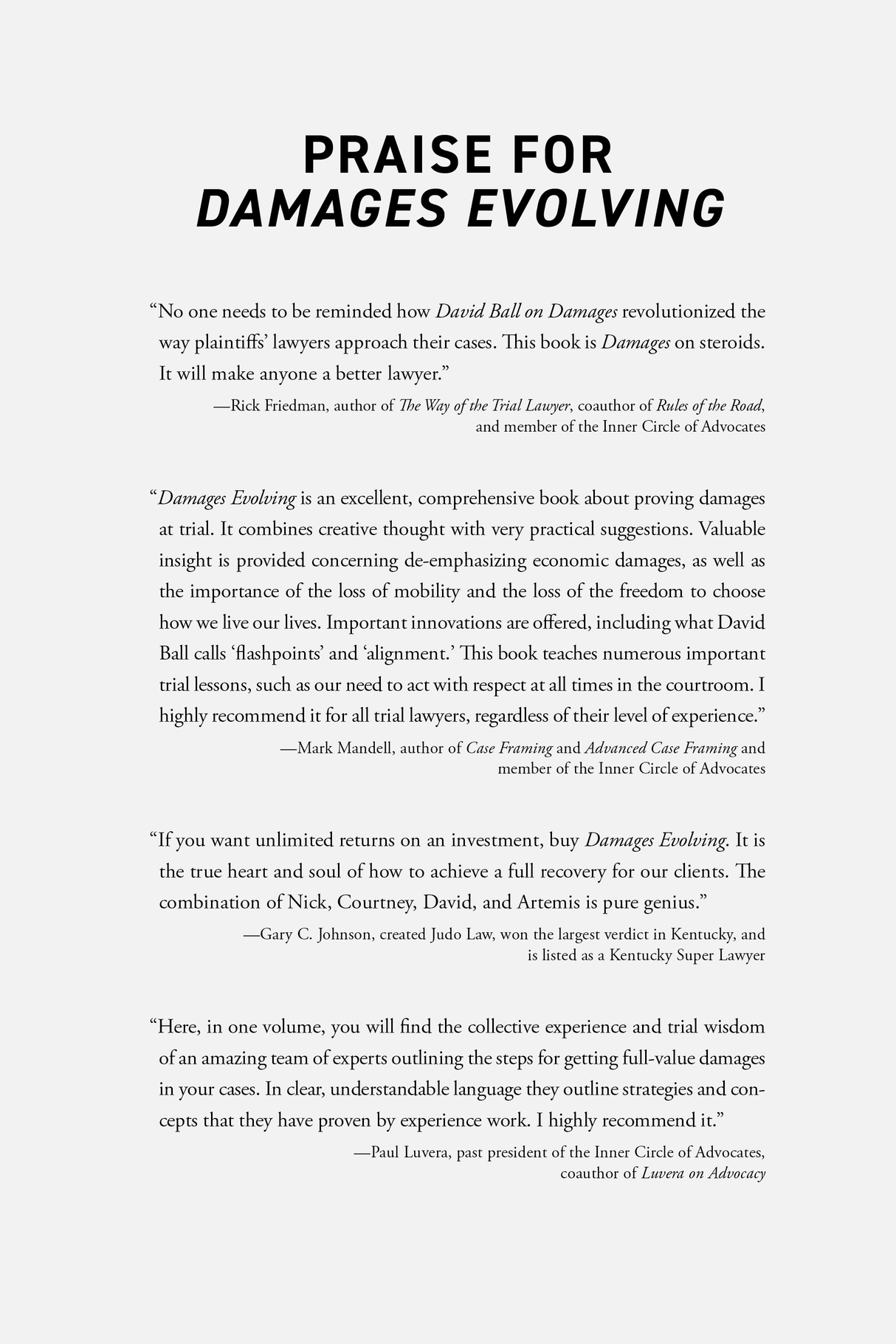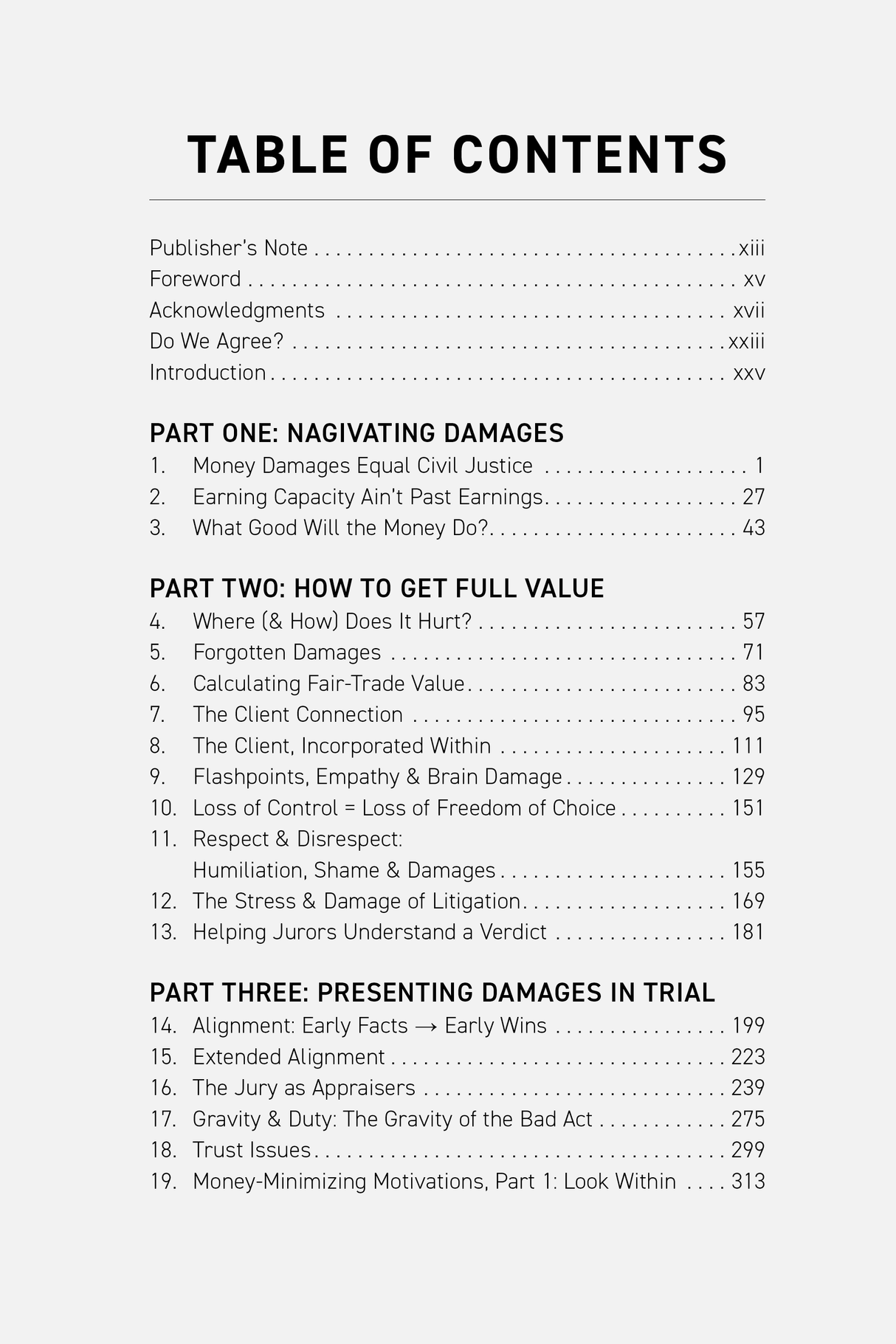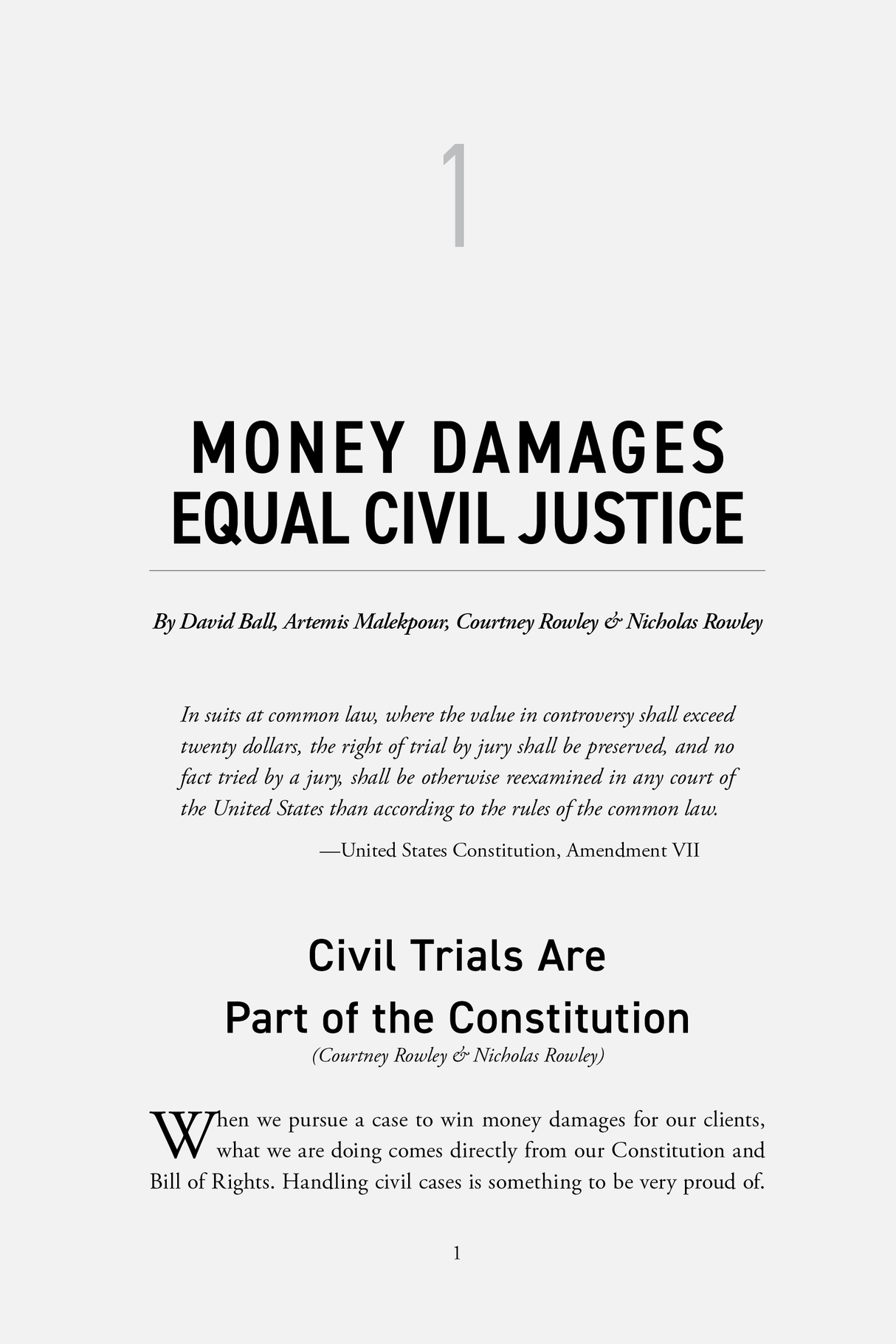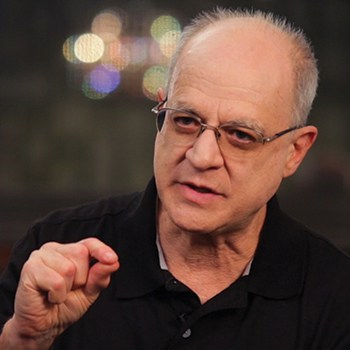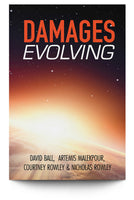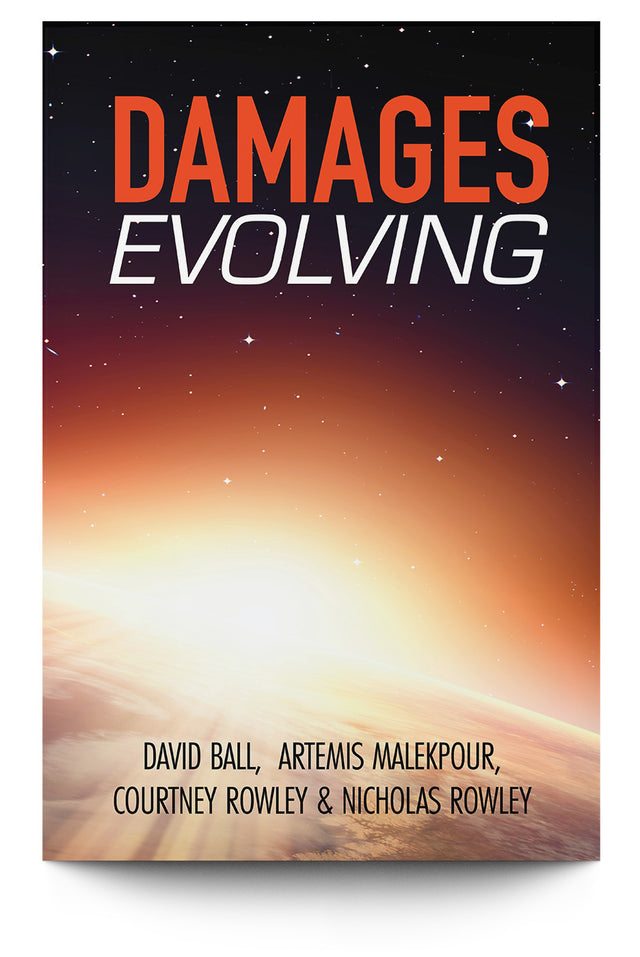Description
Description
In Damages Evolving, authors David Ball, Artemis Malekpour, Courtney Rowley, and Nicholas Rowley (along with contributors Dorothy Clay Sims, Aaron Broussard, and Pate Skene) do more than just share their latest strategies and insights for successfully trying cases on behalf of injured clients.
The authors demonstrate new ways to make your cases stronger, now, today, as well as tomorrow and the days to come. They go beyond templates and examples you can use to solve the problems in your cases and share their reasoning as to why their solutions work, so that you can take their solutions and tailor them to your needs. They offer strategies and frameworks robust enough to give you an edge against unforeseeable changes, and—more importantly—they show you how and when to adapt their lessons to best tackle future challenges.
This new book on damages includes:
- New and tested methods from the authors, built on the latest research
- Numerous in-depth examples and trial transcripts—from a range of cases—that show you how you can apply the authors’ lessons in cases both large and small
- How you can help jurors become unified for justice
- Ways to get jurors to care about and understand your case
- How to teach jurors to value cases based on what truly matters
- Why noneconomic damages, assets, and human stories must become the heart of your cases and trial strategy
- How to better frame and value your clients’ cases through human stories
- Why framing your case around economic damages is wrong and plays into the defense’s hands
- Concepts, such as alignment and respect versus disrespect, that are based on fundamental human nature and do not change even as the world changes around us
- How to weave the value of noneconomic damages together with jury instructions and expert and lay witnesses
- How to deal with defense experts
- Insights for successfully handling jury selection, opening statement, direct and cross-examination, and closing argument
- Necessary updates for David Ball on Damages
As David Ball puts it, “Damages Evolving wants to keep you ahead of the curve as our world—and thus our jurors—undergoes faster and more abrupt changes than we’ve ever seen. Trial lawyers must be armed and ready. Evolution, after all, is the survival of the fittest.”
Do you want the eBook and print book? After you complete your purchase of the print book you will receive a coupon code via email to purchase the eBook for $20.
Authors
Authors
Details
Details
Paperback: 592 pages; 1st edition (2022); ISBN: 978-1-951962-16-6
Publisher: Trial Guides, LLC
Table of Contents
Table of Contents
Publisher’s Note
Foreword by Rick Friedman
Acknowledgments
Do We Agree?
Introduction
Part One: Navigating Damages
- Money Damages Equal Civil Justice
- Civil Trials Are Part of the Constitution
- The Erosion of Economic Damages
- You Are a Civil Rights Attorney
- Get Right with Yourself First
- Conviction Defines Credibility
- De-emphasizing Economic Damages
- Rant: No Fear, No Shame
- Are You in This for the Money?
- Greed?
- Noneconomic Damages Mean Equality & Dignity
- You, Your Client & the Jury Are Civil Justice
- Lawyers Are Leaders
- Trial Example
- The DeJongh Case
- Disrespect
- Conclusion
- Earning Capacity Ain’t Past Earnings
- Earnings versus Earning Capacity
- The Emotional Toll of Lost Earning Capacity
- Earning Capacity, Gender, Race
- Beyond Earning Capacity & Medical Bills
- What about Medical Bills & Life-Care Plans?
- Trial Example: The Guzman Case
- Separating Salary from Human Worth
- The Defense Wants Economic Damages
- Trial Example: The DeJongh Case
- Conclusion
- What Good Will the Money Do?
- Tangibility
- Part 1: Deterrence
- Deterrence & the Client’s Anguish
- Maximum Possible Harm
- Part 2: Healing
- Compensation versus Punitive Damages
- Economics Expert for Punitive Damages
- Don’t Encourage the Defendant to Gamble
- “Exemplary,” Not “Punitive”
- Conclusion
Part Two: How to Get Full Value
- Where (& How) Does It Hurt?
- Thinking You Already Know
- Thinking They Will Just Accept It
- How Did We Get Here, Step by Step
- The Mechanism of Impact
- The Mechanism of Injury
- Mechanisms Explain Aggravated Injuries
- Conclusion
- Forgotten Damages
- Far-Off Consequences
- The Terror of Small Odds
- Other Future Consequences
- Future Consequences in Voir Dire
- Should You Tell Your Client about the Future?
- Conclusion
- Calculating Fair-Trade Value
- Calculating Noneconomic Damages
- Trial Example: The Bronson Case
- Identifying Each & Every Harm
- Linking Items of Harm with Your Client’s Story
- More about Fair Trade
- Conclusion
- Calculating Noneconomic Damages
- The Client Connection
- Why Is She Like That?
- Questions to Dig Deeper
- You Need to Care
- The Trust That Binds
- Getting a Client to Talk
- The Gift of Reassurance
- Ultimately, the Bottom Line
- Conclusion
- Why Is She Like That?
- The Client, Incorporated Within
- When You Bother to Ask
- Factoring the ExhibitThat Is Your Client
- Your Client Is an Exhibit
- Contributing to Your Client’s Harm
- Example: Contributing to Harm
- Limiting Your Client on the Stand
- Trial Example: Child’s Cerebral Palsy Case
- Your Client & the Courtroom (in General)
- Your Client’s Presence, Case by Case
- Explain Your Reasoning in Voir Dire
- Protecting Your Client from Harm
- Conclusion
- Flashpoints, Empathy & Brain Damage
- Flashpoints
- Spotting Flashpoints
- Common Flashpoints
- Flashpoint versus Empathy
- How Do Flashpoints Work?
- How to Use Flashpoints
- Four Primary Brain Damage Flashpoints
- Combining Flashpoints in a Brain Damage Case
- Isolation
- Lack of Mood Control
- Immobility
- Shame & Humiliation
- Enforced Endless Boredom
- What Good Will Money Do for Brain-Damaged Clients?
- The Real Effects of Brain Injury
- Trial Example: The Lyons Case
- Use Concrete Examples
- Conclusion
- Flashpoints
- Loss of Control = Loss of Freedom of Choice
- Mood & Control
- Conclusion
- Respect & Disrespect
- Disrespect
- 1. Disrespect of the Negligent Act
- 2. Disrespect of Consequences of Injuries
- 3. The Pinnacle of Disrespect—Refusal to Redress
- 4. Disrespect of You, Your Client & the Jurors
- Suggested Reading: Malingering & Symptom Exaggeration
- Disrespect & You
- Disrespect & Motivating Damages
- Expert on Respect
- Trial Example: The Lyons Case
- Conclusion
- Disrespect
- The Stress & Damage of Litigation
- Trial Is Terrifying
- Talking about Anxiety at Trial
- Opening Statement
- Testimony
- Closing
- Trauma & Trial
- Your Client’s Injuries Over Time
- Trial Example: The Bronson Case
- Trial Example: The Lyons Case
- Don’t Let Jurors Have False Impressions
- Conclusion
- Helping Jurors Understand a Verdict
- How (& What) Do Jurors Value?
- Jurors Need to Trust You
- Look for Jurors Who Don’t Care Enough
- Look for Jurors’ Identity in Their Careers
- Look for Jurors Who “Would Find a Way”
- Reframing: Plaintiff Who Is Trying to Work
- Finding (& Framing) Common Values
- Where Is There Hope
- Inspiration from TV: Accident
- Recovery Documentaries
- Jurors Look to the Plaintiff’s Striving to Get Better
- Conclusion
- How (& What) Do Jurors Value?
Part Three: Presenting Damages in Trial
- Alignment
- Facts First
- What Is Alignment?
- Template for Opening
- Why Alignment Works
- Guidelines for the Alignment Story
- How to Build a Basic Alignment
- Choosing the Rules for Alignment
- Umbrella Rule
- Specific Rule
- Alignment with Comparative Negligence
- Conclusion
- Extended Alignment
- Example of Extended Alignment
- Conclusion
- The Jury as Appraisers
- What Appraisers Do
- Accurate Appraisals & the Defendant’s Bad Acts
- Opening Statement
- Introduction
- Detailed & Comprehensive—Not Estimates
- Appraisers Do Not Judge Books by Their Covers
- The Total Appraisal Amount Is Not What Matters
- A Note about Runaway Juries
- Appraisals Are Not Based on Guesswork
- Appraisals Are Consistent
- Facts & Evidence, Not Personal Beliefs
- Appraisals Require Full & Honest Disclosure
- Appraisers Do Not Factor in Feelings or Intent
- Closing Argument
- Voir Dire
- Conclusion
- What Appraisers Do
- Gravity & Duty
- Gravity of Bad Act 1: Maximum Foreseeable Harm
- Gravity of Bad Act 2: History
- Two Foreseeabilities
- Foreseeability in Opening
- History Questions for Testimony
- Gravity of Bad Act 3: Spreading the Dangers
- Gravity of Bad Act 4: Patterns & Contrasts of Bad Conduct
- Patterns Undermine Defense
- Life-Care Plans
- Pattern-Based Killer Closing
- Gravity of Bad Act 5: The Power of Duty
- Duty & Defensive Attribution
- Duty & the Judge
- Conclusion
- Trust Issues
- Banking on “The Elites”
- Credible Sources
- Who Tells Your (Damages) Story
- Elsewhere in the Courtroom
- What “Truths” Can Be Found Online?
- Conclusion
- Money-Minimizing Motivations, Part 1
- Never Would I Ever . . .
- How You Present Your Story Matters
- Flip the Script: Focus on the Defendant
- Address What the Plaintiff Did
- When Your Client Is the Perceived Danger
- Show How Your Client Was Safe
- Find Out about Your Client’s Actions
- Responsibly Responding to Responsibility
- Apportionment & Rules
- Rules Go Both Ways
- Conclusion
- Never Would I Ever . . .
- Money-Minimizing Motivations, Part 2
- Family Matters, the Liability Edition
- What Should the Family Have Done?
- Voir Dire Questions about Families
- Preparation Questions for Your
- Client’s Family
- Explore the Family’s Decision-Making
- Processes
- Family Matters, the Damages Edition
- Perceptions about the Family’s
- Interests
- Family Members & Credibility
- The Empty Chairs
- Maybe It Was Something Else
- Conclusion
- Family Matters, the Liability Edition
- Fair & Impartial Jurors
- It Is Not Preconditioning or Anchoring
- Tell Jurors What Their Job Is Going to Be
- Jurors Appreciate Knowing in Advance
- What If Yours Was a Criminal Death
- Penalty Case?
- Specific Dollar Amounts without Preconditioning
- Trial Example: Judge Biased against
- Noneconomic Damages
- Mini-Opening Statements Reveal Juror Bias
- Trial Example: The Guzman Case
- Conclusion
- It Is Not Preconditioning or Anchoring
- Jury Selection & Opening Statement
- Voir Dire & Brutal Honesty
- Trial Example: The Hoang Case
- Irksomely Bogus Defense Tactic
- Opening Statement
- Trial Example: The Von Normann Case
- Conclusion
- Voir Dire & Brutal Honesty
- Direct & Cross-Examination: Proving the Full Value of Noneconomic Damages
- Direct Examination
- Trial Example: The DeJongh Case
- Cross-Examination
- Trial Example: The Alvarez Case
- Conclusion
- Direct Examination
- Experts, Cheating & Damages, Part 1
- The Reliability Test
- Intentional Cheating Is a Damages Driver
- Background Information on Each Requisite
- Jurors Don’t Need to Understand All Processes
- How Do the Reliability Requisites Neutralize Biases?
- The Power of Bias on Human
- Decision-Making
- Convincing the Judge
- The Makes-No-Difference Excuse
- The Big Bonus: Jurors Don’t Need to Know the Science
- The Trade-Secret Excuse
- Checking the Analysis (Requisite Three) Analogies
- Non-Opinion Experts
- Questions for Your Experts in Trial
- Conclusion
- The Reliability Test
- Experts, Cheating & Damages, Part 2
- Expertise: Fact or Fiction?
- Check the Expert’s CV
- Use Listservs for Research
- What to Do with All This Material?
- Use the Expert’s Own Codes of Ethics
- Video-Record the Exam
- What Should You Subpoena?/li>
- How to Read an Expert’s Report
- Using Report Misrepresentations at Depositions & Trial
- Preparing Exhibits for Depositions & Trial
- During the Deposition
- Ask Questions the Right Way
- If the Expert Is an Author
- Supplement A: Misrepresented Medical Exam
- Supplement B: Findings Left Out of the Defense Report
- Supplement C: Spasm Chart
- Supplement D: CV Experience Chart
- Conclusion
- Expertise: Fact or Fiction?
- Closing & Rebuttal: Less than Full Justice Is Injustice
- Objections in Closing
- The Right to Argue Self-Evident Information
- Trial Example: The Huitt Case
- Reasonable Compensation = 100%
- Rebuttal
- Rely on Facts & Evidence
- Trial Example: The DeJongh Case
- Don’t Give Jurors a Conclusion
- Conclusion
- Don’t Get Grounded by Economic Damages
- Medical Bills Are Often the Smallest Damages
- Trial Example: The Bronson Case
- Conclusion
- Medical Bills Are Often the Smallest Damages
- The Practice of Kindness
- Kindness & Anger
- Establishing Yourself as a Trusted
- Authority
- First Impressions
- Methods & Kindness Matter
- The Unintended Slight
- Be Kind, All the Time
- Conclusion
- Kindness & Anger
- Conclusion: Don’t Ask, Do Tell
Appendices
- Appendix A: Updates to David Ball on Damages, 3rd Edition
- Appendix B: Signs of Possible Brain Damage
- Appendix C: Brief for Limiting Objections in Closing Argument
Index
About the Authors
Template for Opening
Free Chapter Sample
Free Chapter Sample
What Legal Leaders Are Saying
— Rick Friedman, author of The Way of the Trial Lawyer, coauthor of Rules of the Road, and member of the Inner Circle of AdvocatesNo one needs to be reminded how David Ball on Damages revolutionized the way plaintiffs’ lawyers approach their cases. This book is Damages on steroids. It will make anyone a better lawyer.
— Lisa Blue, past president of the AAJ and coauthor of Preparing for Voir Dire and Conducting Voir DireIn this highly accessible book, these authors explain everything you need to know about damages. We have all struggled with the best way to present damages and this great read provides the key to success. Everything is covered from ‘what good with the money do’ to (my personal favorite) ‘kindness’ (thanks Artemis). It is as if these brilliant authors have analyzed why trial lawyers failed in their presentations of damages and have given us the magic answers. I never thought any book could top David Ball’s book on damages but this book is the magical twin of Damages 3. A must read for all trial lawyers that want to up their game on damages!
— Edward Capozzi, president of the New Jersey Association for Justice and author of The Domino TheoryIn their new book, Damages Evolving, David, Artemis, Nick, and Courtney prove there is no one way to prove damages. This book gives their individual and collaborative viewpoints on proving damages in an everchanging world. As times change, our ways of proving damages must change. These authors not only explain and teach more effective ways to prove damages today, they foresee what proving damages into the future will look like. Absolutely brilliant!
— Shana De Caro, chairwoman of the Brain Injury Association of America, past chair of the AAJ Traumatic Brain Injury Litigation Group, vice president of the American Academy of Brain Injury Attorneys, and member of the Board of Directors of the New York State Academy of Trial LawyersDamages Evolving provides innovative yet timeless insight into presenting all types of damages to a jury. It’s especially enlightening for those representing survivors of brain injury, which is uniquely difficult to communicate. This book reminds us why we do what we do, what we value, and how we convey that to a jury. I highly recommend adding this book to your arsenal.
— Amy Pardieck, trial consultant at Perceptual Litigation, LLCThis book is a rare treasure, in which Nick and Courtney do what David and Artemis teach and David and Artemis teach what Nick and Courtney do. What this book does differently is collect a vast array of tools, techniques, and different perspectives all in one place. Artemis brings the jurors’ perspective to the fore, David’s historical knowledge spans time and depth, while Nick and Courtney’s embodiment of the trial lawyers’ lens before and during trial jumps off each page. This book has been on my shelf for four weeks and I find myself reaching for it on a daily basis when editing opening statements, listing topics for witness examinations, drafting closing arguments, and reframing landmines, in addition to the moments when I simply need a nudge to get the creative juices going. This is the ultimate reference for plaintiffs’ trial attorneys and consultants, providing up-to-date strategies, storylines, and tried-and-true approaches for the unique challenges we face with today’s jurors.
— Katie Bertram, 2018 and 2019 top medical malpractice verdicts in DC and VirginiaThis book is pure gold. David, Artemis, Courtney, and Nick synthesize the top trial strategies of our times, give credit where credit is due, and acknowledge there are differences and that is okay. They also weave in new turbo-charged methods that will help us teach jurors how to avoid the traps of tribalism and divisiveness and bring juries together to obtain justice for our clients.
— Karen Evans, past president of the National Black Lawyers Top 100, and past president of the Trial Lawyers Association of Metropolitan Washington, DCDamages Evolving turns the adage ‘you can’t teach an old dog new tricks’ on its head. Damages Evolving is for every trial lawyer, experienced and novice, who wants to be the best and satisfy the only goal of trial—to get money for your client. As an ‘old dog’ who learned new tricks from ideas sparked by reading Damages Evolving, especially chapter 10, I say thanks to Artemis, Courtney, Nick, and David for sharing. I love that the sections stand alone, which allowed me to quickly find what was needed as I prepared for trial without having to read every preceding word.
— Charles Zauzig, past president of the Virginia Trial Lawyers Association and fellow of the American College of trial lawyersThis is a book for those of us who seek civil justice for our clients from a jury. Trials are not won using paint-by-number formulas but by critically thinking through the strategies for a particular case. David et al. set forth ideas, tactics, strategies, and philosophies that are meant to be considered, learned, and modified. This stuff rings true. Check for example jurors as appraisers and alignment (on steroids). Having tried cases for over 40 years, I could not put the book down.
— Karen Koehler, founder of the Velvet Hammer and past president of the Washington State Association for JusticeDamages Evolving helps trial lawyers feel their way into the hearts of their clients’ damages stories and explores the moral value of assessing human damages so that juries can provide righteous justice. A must read.
— Jalil Dozier, trial lawyer, Dozier Law Firm PLLCDamages Evolving is an excellent addition to the research on litigation theory, particularly the chapters discussing building rapport with clients, presenting clients as exhibits (while protecting them from further harm), and respect and disrespect. David and Artemis continue to build on their well-developed empirical research on how best to communicate with juries, while Courtney and Nicholas demonstrate how they have deployed these strategies to secure record-breaking outcomes. This book is essential reading for trial lawyers committed to bearing witness to justice at the highest level.
— Mark Mandell, author of Case Framing and Advanced Case Framing and member of the Inner Circle of AdvocatesDamages Evolving is an excellent, comprehensive book about proving damages at trial. It combines creative thought with very practical suggestions. Valuable insight is provided concerning deemphasizing economic damages, as well as the importance of the loss of mobility and the loss of the freedom to choose how we live our lives. Important innovations are offered, including what David Ball calls ‘flashpoints’ and ‘alignment.’ This book teaches numerous important trial lessons, such as our need to act with respect at all times in the courtroom. I highly recommend it for all trial lawyers, regardless of their level of experience.
— Ernie Teitell, lawyer of the year for Medical Malpractice Law—Plaintiffs, Stamford, CT, 2021 and adjunct professor at Quinnipiac University School of LawFor many years now, David Ball’s books on damages have been the authoritative text and mandatory reading for us trial lawyers. Now with the changing times, this new book is again required reading. With his coauthors sharing additional viewpoints, the reader will feel like being in the middle of a ‘trial advocacy critical thinking’ master class. We all owe Ball, Malekpour, and the Rowleys a big debt of gratitude for writing this book.
— Todd Smith, past president of American Association of Justice and member of the Inner Circle of AdvocatesI find it hard to accept that Damages Evolving may be David Ball’s last, as he proclaims. . . . . [W]ith this extraordinary ‘last’ effort he brings the outstanding talents and vision of Artemis Malekpour, Courtney Rowley, and Nick Rowley. This will ensure the ‘evolution’ continues. Any trial lawyer, whether new to the pursuit of justice for the harms caused by others or a seasoned veteran will benefit enormously from Damages Evolving. Our gratitude to David for providing his brilliance for all of us in these pages and for bringing along with him such extraordinary talents.
— Gary C. Johnson, created Judo Law, won the largest verdict in Kentucky, and is listed as a Kentucky Super LawyerIf you want unlimited returns on an investment, buy Damages Evolving. It is the true heart and soul of how to achieve a full recovery for our clients. The combination of Nick, Courtney, David, and Artemis is pure genius.
— Paul Luvera, past president of the Inner Circle of Advocates, coauthor of Luvera on AdvocacyHere, in one volume, you will find the collective experience and trial wisdom of an amazing team of experts outlining the steps for getting full-value damages in your cases. In clear, understandable language they outline strategies and concepts that they have proven by experience work. I highly recommend it.
— Donald H. Beskind, trial lawyer and full-time law professor at Duke LawFour great authors with hundreds of new ideas and ways of thinking about damages. Thank you, David, Artemis, Courtney, and Nick. Why has it taken so long for the four of you to write this book? So many great ideas about damages to steal—and all from one place. Damages Evolving helps us empower the jury to fight for justice for those who entrust their futures to us. Just doing that makes it worthwhile reading—and rereading. But Damages Evolving empowers us, too, to keep evolving and struggling against the dangerous complacency old habits.
— Roxanne Conlin, member of the Inner Circle of Advocates, first woman president of the AAJ, partner/owner of Roxanne Conlin & Associates, P.C.These authors have written several comprehensive books on trials and jury science. I thought there would be very little left to say. But I was wrong. There are practical, creative, and easily adopted suggestions for every aspect of a trial from beginning to end. Trying cases is almost always a gamble, but you can significantly increase your odds of winning an adequate verdict for your clients by absorbing the advice in this excellent book. I have a been a trial lawyer for 55 years and I learned something new and useful in every single chapter. This is simply the best book I have ever read on how to win cases for injured people.
— Keith Mitnik, author of Don't Eat the Bruises and Deeper Cuts, and senior trial counsel at Morgan & Morgan, the largest personal injury firm in the countryThe collective wisdom of my friends David, Artemis, Courtney, and Nick is staggering, so I expected great things. Beyond the fantastic insights, what struck me was the courage on every page. It takes courage and conviction to pursue maximum justice. It is easier to teach strategies than to dare delve into those core elements. This book is like having a gathering of wizards join in an epic quest where right and wrong hang in the balance. For the sake of us all, please read this fabulous book.
— Randi McGinn, first woman president of Inner Circle of Advocates and author of Changing Laws, Saving LivesFor those of us who were raised with the belief that it was not polite to talk about money, this book is the perfect antidote. This dream team of trial consultants and trial lawyers shares wisdom learned over years working inside and outside the courtroom with focus groups. They raise, and help you answer, the hard questions that stand between you and a fair verdict. What good will the money do? How lost earning capacity and future potential is so much greater than a mere calculation of lost wages. How a verdict can result in justice. Whether you’ve struggled when asking for money or just need a new approach to damages, you need this brilliant book.
— Ann Oldfather, member of the Inner Circle of Advocates, regularly rated in the top ten or top three trail lawyers in Kentucky by Super Lawyers, listed in Best Lawyers since 1993What a team: proven and experienced top-of-their game Artemis Malekpour and David Ball are joined by rising superstars Courtney and Nick Rowley, with one creative idea after another. And along the way, they encourage us to be brave, inventive, and bold. I never try a case without a re-read of Damages 3, and it is typically thoughtful of Ball to provide an Appendix A with a cut and paste set of updates for my dog-eared copy. But perhaps a waste of paper, David, as Damages Evolving is certain to replace it as my new go-to.
— Patrick Regan, fellow of the American College of Trial Lawyers, and member of the Board of Governors for the AAJSince the publication of his seminal work, David Ball on Damages, David Ball’s teachings have been required reading for trial lawyers. In the last 20 years, I have never prepared for trial without consulting and re-reading Damages. With Damages Evolving, David has combined with his longtime colleague, Artemis Malekpour, and the incredible trial lawyers Nick and Courtney Rowley to move the needle even further. Damages Evolving belongs on the desk, not bookshelf, of every trial lawyer.

